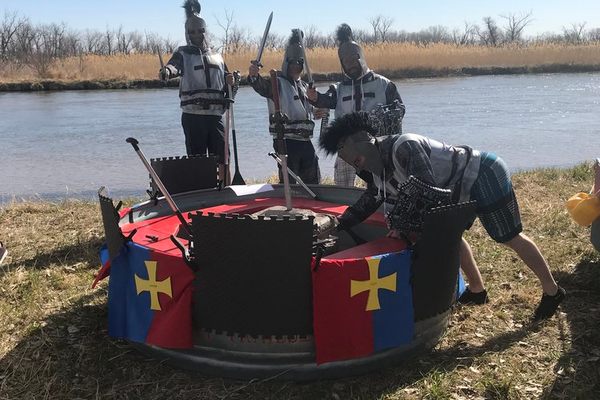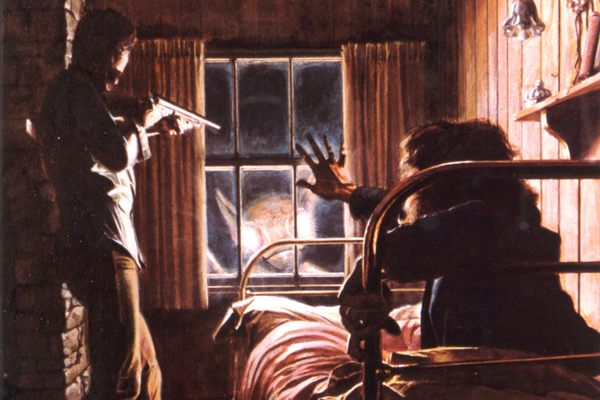The Oldest Rowboat Ferry in England Is Not Slowing Down
The same family has been crossing the River Blyth for six generations.
Dani Church helps her passengers—a vacationing family of six, a solo hiker, and a reluctant golden retriever—into a rowboat, directing them to particular seats to ensure that the 12-person craft sits evenly in the water. She hauls on the oars to maneuver into the channel, steering the boat in a wide arc downstream as she lets the tide help her on her way. She’s rowed the Southwold-Walberswick ferry across the River Blyth, in southeast England, an estimated 40 times a day, 5 days a week, 6 months a year for 22 years.
Not much has changed about this journey in the time Church has been operating the oldest manual rowboat service in the United Kingdom. The brown-gray water of the Blyth still sloshes against the wood of the creaking jetty; oystercatchers still forage in the mud of the riverbank; clouds still scud across the huge Suffolk sky. But then not much has changed since her great-grandfather’s uncle took it over in 1885 either.
In fact, not much has changed in almost 800 years; there’s been a ferry across the Blyth since at least 1236. The river flowed out to sea three miles down the coast at Dunwich in that period, and the ferry would have been a key service to get local workers across the large port of this bustling medieval town.

Church had no idea how far back the history of the ferry went until after the untimely death of her father, David Church, in 2001, when she began research on a pamphlet about it in tribute to him. “People sent me all these photographs because his death was in the paper,” she recalls. That prompted a trip to the local records office. “I was just amazed,” she says. “I thought it was my great granddad and his family who had started it.” The pamphlet became a book, The Story of the Southwold-Walberswick Ferry, published in 2009 and still available today at the ferry hut on the Walberswick side of the Blyth.
Over the centuries, Church learned, the course of the waterway and the shape of the coastline changed, shifting the commercial focus from Dunwich, to Southwold and Walberswick. Ferries came and went, including, from 1885 to 1942, a chain-cranked pontoon ferry capable of transporting large vehicles. Benjamin Cross, uncle to Church’s great-grandfather, Bob Cross, was the first ferryman to work the pontoon. Last summer Church’s 18-year-old nephew Oscar joined the business, the sixth generation of the family to ferry passengers across the Blyth.

Records that Church found from the 13th century outlined the right of the ferry license holder to charge one halfpenny for a man and horse to cross the River Blyth. There’s no space for a horse in Church’s rowing boat today—or indeed, in the motorboat she runs across this 164-foot stretch of river on particularly busy or windy days. But dogs are always welcome (free of charge) on the five-minute journey as are strollers (also gratis), and bikes (£2 each, the same price as a single adult crossing). Church gives all her passengers a warm reception but the four-legged friends hold a special place in her heart, sparking fond memories of Nellie, her late giant schnauzer, who used to join her on every crossing.
The main industry in this part of the world today is tourism rather than fishing, but the ferry is no less vital for all that. Without it, locals and vacationers wishing to travel between Southwold Harbour and the picture postcard village of Walberswick must either walk four miles via a footbridge, or go by road, a drive of about 20 minutes.
There’s a brisk breeze blowing on the north side of the river the morning of my visit, making life difficult for Church as she rows boatloads of tourists back and forth. “Windy days are definitely the worst,” she says. “It’s just exhausting.” Not that you can tell: Church rows with a smile on her face, chatting cheerfully throughout, whether answering my questions, offering recommendations to tourists or gossiping with regulars. She won’t get a break of more than a couple of minutes until the end of her four-hour shift, but Church doesn’t mind that. “It’s stop-start, stop-start, so you don’t feel it too much. It does make you hungry though!”

At the end of her shift, she’ll hand over to another rower, and so it will continue until the end of October, when the ferry shuts up shop for the winter. Cue months of maintenance for Church: sanding, repairing, and repainting the two wooden rowboats, Boy Charlie and Halcyon Days, and engine servicing and fiberglass repairs on Daybreeze, the motorboat she uses for riverboat tours.
Church doesn’t know what the future holds for this centuries-old operation—maybe, if he wants to, her 16-year-old son Charlie will take over one day. In the meantime, Church plans to keep things as traditional as possible. “It’s still pretty much the same as it was 800 years ago, and it’s still as successful as it was then.”






















Follow us on Twitter to get the latest on the world's hidden wonders.
Like us on Facebook to get the latest on the world's hidden wonders.
Follow us on Twitter Like us on Facebook